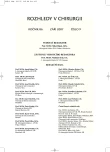Method of Approximative Intestinal Anastomosis in Experimental Model
Authors:
M. Rygl; R. Škába; J. Herget *; J. Šnajdauf
Authors‘ workplace:
Klinika dětské chirurgie UK Praha 2. LF a FN Motol, Katedra dětské chirurgie IPVZ, Praha, přednosta
prof. MUDr. J. Šnajdauf, DrSc.
; Klinika dětské chirurgie UK Praha 2. LF a FN Motol, Katedra dětské chirurgie IPVZ, Praha, přednosta
Ústav fyziologie UK Praha 2. LF, vedoucí: prof. MUDr. J. Herget, DrSc.
*
Published in:
Rozhl. Chir., 2007, roč. 86, č. 9, s. 501-504.
Category:
Monothematic special - Original
Overview
Aim:
A technique of approximative anastomosis in witch integrity and continuity of bowel is achieved with limited number of interrupted seromuscular stitches was evaluated in experimental study.
Material and methods:
Small bowel anastomosis were performed in twelve rats (Wistar, male) with weight range 197–242 g. An approximative anastomosis in the ileum of six rats was performed with five seromuscular-interrupted sutures only; in the second study group anastomosis was performed with conventional technique of interrupted sutures. The approximative anastomosis was evaluated concerning operating time, anastomotic healing, bursting pressure and adhesions in comparison to the conventional anastomosis. Statistics was calculated with Anova test.
Results:
All anastomosis in both group healed well without obstruction. The median operating time needed for approximative anastomosis was shorter (31.7 ± 1.6 minutes versus 35.2 ± 1.5 minutes, p = 0.002). The strength of approximative anastomosis after 7 days was 249 ± 39 torr; strength of standard anastomosis was 218 ± 23 torr (p = 0.118). There were no significant differences in the others evaluated parameters between two study groups.
Conclusion:
In the animal model presented, the approximative anastomosis shows time saving alternative to standard anastomosis, with the same parameters of anastomotic strength, healing, and adhesions.
Key words:
aproximative anastomosis – conventional anastomosis – anastomotic strength – multifocal necrotizing enterocolitis
Sources
1. Hall, N. J., Curry, J., Drake, D. P., Spitz, L., Kiely, E. M., Pierro, A. Resection and primary anastomosis is a valid surgical option for infants with necrotizing enterocolitis who weigh less than 1000 g. Arch. Surg., 2005; 140 : 1149–1151.
2. Hofman, F. N., Bax, N. M., van der Zee, D. C., Kramer, W. L. Surgery for necrotising enterocolitis: primary anastomosis or enterostomy? Pediatr. Surg. Int. 2004; 20 : 481–483.
3. Singh, M., Owen, A., Gull, S., Morabito, A., Bianchi, A. Surgery for intestinal perforation in preterm neonates: anastomosis vs stoma. J. Pediatr. Surg., 2006; 41 : 725–729; discussion 725–729.
4. Thornton, F. J., Barbul, A. Healing in the gastrointestinal tract. Surg. Clin. North Am., 1997; 77 : 549–573.
5. Golub, R., Golub, R. W., Cantu, R., Jr., Stein, H. D. A multivariate analysis of factors contributing to leakage of intestinal anastomoses. J. Am. Coll. Surg., 1997; 184 : 364–372.
6. Nordkild, P., Hjortrup, A., Kjaergaard, J. Tissue adhesives and intestinal anastomosis. Ann. Chir. Gynaecol., 1986; 75 : 205–208.
7. Jonsson, T., Hogstrom, H. Effect of suture technique on early healing of intestinal anastomoses in rats. Eur. J. Surg., 1992; 158 : 267–270.
8. Hjortrup, A., Nordkild, P., Kiaergaard, J., Sjontoft, E., Olesen, H. P. Fibrin adhesive versus sutured anastomosis: a comparative intraindividual study in the small intestine of pigs. Br. J. Surg., 1986; 73 : 760–761.
9. Haukipuro, K. A., Hulkko, O. A., Alavaikko, M. J., Laitinen, S. T. Sutureless colon anastomosis with fibrin glue in the rat. Dis. Colon Rectum, 1988; 31 : 601–604.
10. Havlíček, K., Vlček, B. Reinforcement anastomoses in the small intestine with fibrin glue (experimental study). Rozhl. Chir., 1992; 71 : 314–319.
11. Hendriks, T., Mastboom, W. J. Healing of experimental intestinal anastomoses. Parameters for repair. Dis. Colon Rectum, 1990; 33 : 891–901.
12. Ordorica-Flores, R. M., Bracho-Blanchet, E., Nieto-Zermeno, J., Reyes-Retana, R., Tovilla-Mercado, J. M., Leon-Villanueva, V., Varela-Fascinetto, G. Intestinal anastomosis in children: a comparative study between two different techniques. J. Pediatr. Surg., 1998; 33 : 1757–1759.
13. Siemonsma, M. A., de Hingh, I. H., de Man, B. M., Lomme, R. M., Verhofstad, A. A., Hendriks, T. Doxycycline improves wound strength after intestinal anastomosis in the rat. Surgery, 2003; 133 : 268–276.
14. Syk, I., Agren, M. S., Adawi, D., Jeppsson, B. Inhibition of matrix metalloproteinases enhances breaking strength of colonic anastomoses in an experimental model. Br. J. Surg., 2001; 88 : 228–234.
15. Hogstrom, H., Haglund, U., Zederfeldt, B. Suture technique and early breaking strength of intestinal anastomoses and laparotomy wounds. Acta Chir. Scand., 1985; 151 : 441–443.
Labels
Anaesthesiology, Resuscitation and Inten Paediatric surgery Paediatric urologist Vascular surgery Chest surgery Maxillofacial surgery Plastic surgery Surgery Intensive Care Medicine Cardiac surgery Cardiology Neurosurgery Clinical oncology Orthopaedics Burns medicine Orthopaedic prosthetics Rehabilitation Nurse Traumatology Trauma surgery Urology Medical studentArticle was published in
Perspectives in Surgery

2007 Issue 9
Most read in this issue
- Indirect Antireflux Procedures in Gastroesophageal Reflux Disorders
- Symptomatic Meckel’s Diverticulum in Children
- Occlusive Ileus Caused by Intestinal Duplication
- Preliminary Experience in Minimally Invasive Video Assissted Parathyroidectomy
